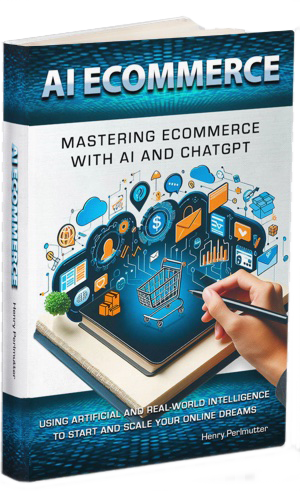How AI is Reshaping Ecommerce Jobs: Innovation or Job Displacement?
AI in ecommerce isn't just a distant promise anymore. It’s the present reality and it's here to stay. From the moment you land on an online store, AI is working behind the scenes: recommending products, answering your questions, managing inventory and even predicting what you’ll want to buy next.
Henry Perlmutter
5/13/20254 min read


For businesses, the benefits are tantalizing: faster operations, lower costs and happier customers. But as AI’s influence grows, so does a provocative question:
Are we witnessing an era of unprecedented innovation, or are we sleepwalking into a future where human jobs are the collateral damage of progress?
Let’s dive into the heart of this debate and explore how AI is reshaping ecommerce jobs, for better and for worse.
The Current Landscape: AI in Ecommerce Operations
AI’s fingerprints are almost everywhere in modern ecommerce. Consider these examples:
Warehouse Automation: Robots zip through fulfillment centers, picking and packing orders with superhuman speed and accuracy. Amazon’s Kiva robots are famous, but similar systems are now commonplace across the industry.
Customer Service Chatbots: AI-powered chatbots handle millions of customer inquiries daily, providing instant answers and resolving issues without human intervention.
Personalized Marketing: Machine learning algorithms analyze browsing history, purchase patterns, and even social media activity to deliver hyper-targeted ads and product recommendations.
Inventory Management: Predictive analytics help retailers optimize stock levels, reducing waste and ensuring popular items are always available.
According to a 2024 report by McKinsey, over 60% of ecommerce businesses have implemented some form of AI automation, and that number is climbing fast. The promise? Streamlined operations, delighted customers, and a healthier bottom line.
But what about the people behind the scenes?
Job Displacement: The Real Concerns
For every story of AI-driven efficiency, there’s another about jobs at risk. The roles most vulnerable to automation are often the ones that have been the backbone of ecommerce’s explosive growth:
Warehouse Workers: Automated picking, packing, and even delivery robots are reducing the need for human labor in fulfillment centers. In 2023, a major online retailer announced a 20% reduction in warehouse staff after deploying a new fleet of robots.
Customer Service Representatives: Chatbots and AI-powered email responders are handling basic queries, leaving fewer entry-level positions for humans.
Data Entry and Routine Admin: Tasks like updating product listings, managing returns, and processing orders are increasingly handled by AI systems.
The consequences are real. In communities where ecommerce warehouses are major employers, automation threatens to erode local job markets. Workers face wage pressure and job insecurity, especially those without the skills to transition into new roles. A 2024 Pew Research study found that 40% of ecommerce workers worry their jobs could be automated within the next five years.
Innovation and New Opportunities
But the story isn’t all doom and gloom. While AI is automating some jobs, it’s also creating entirely new categories of work-roles that didn’t exist a decade ago:
AI Trainers and Supervisors: Humans are needed to train, monitor, and refine AI systems, ensuring they understand context, nuance, and customer needs.
Data Analysts and Ecommerce Strategists: As AI generates more data, businesses need skilled analysts to interpret insights and shape strategy.
AI-Enhanced Customer Experience Managers: These professionals blend human empathy with AI tools to deliver personalized, memorable shopping experiences.
Forward-thinking companies are investing in upskilling and reskilling their workforce. Walmart, for example, has launched extensive training programs to help warehouse workers transition into tech-focused roles. Shopify offers online courses for employees to learn about AI and data analytics.
Perhaps most exciting is the potential for AI-human collaboration. Rather than replacing workers, AI can augment their abilities. Imagine a customer service rep using an AI assistant to instantly access customer history, suggest solutions, and even translate languages in real time. The result? Higher productivity, better job satisfaction, and improved customer outcomes.
The Ethical and Social Debate
Here’s where things get thorny. Should ecommerce companies prioritize efficiency and profit above human employment? Is it ethical to automate jobs without providing a safety net for displaced workers? These questions are no longer theoretical-they’re urgent.
Businesses have a responsibility to manage the transition thoughtfully. That means:
Transparent communication about automation plans and their impact on jobs.
Investment in employee development, not just technology.
Ethical deployment of AI, ensuring systems are fair, unbiased, and respect privacy.
Governments also have a role to play. Policy solutions might include:
Universal Basic Income or wage subsidies for displaced workers.
Publicly funded retraining programs to help workers acquire new skills.
Regulations to ensure AI deployment doesn’t exacerbate inequality or discrimination.
The stakes are high. If we get this wrong, we risk widening the gap between tech-savvy “winners” and everybody else.
What Ecommerce Leaders Should Do Now
For ecommerce executives and entrepreneurs, the path forward is clear-but not easy. Here’s what responsible leaders should focus on:
Balance Automation with Workforce Sustainability: Don’t automate for automation’s sake. Consider the broader impact on your employees and your brand’s reputation.
Invest in Employee Development: Offer training, mentorship, and clear pathways for workers to transition into new roles. Make learning a core part of your company culture.
Embrace AI as a Tool for Empowerment: Use AI to augment human abilities, not just replace them. Look for opportunities where AI and humans together can deliver better results than either alone.
Foster Open Dialogue: Involve employees in conversations about AI adoption. Listen to their concerns and ideas-they’re often your best source of insight.
Champion Ethical AI: Advocate for fair, transparent, and inclusive AI practices, both within your company and across the industry.
Innovation with Compassion or Cold Automation?
AI is reshaping ecommerce jobs at a breathtaking pace. For some, it’s a ticket to new opportunities, higher wages, and more meaningful work. For others, it’s a source of anxiety and uncertainty. The truth is, the future of ecommerce jobs isn’t predetermined-it’s being written right now, by the choices we make as business leaders, policymakers, and consumers.
Will we use AI to build a more innovative, inclusive, and human-centered marketplace? Or will we let automation drive us toward a colder, less compassionate future? The answer depends on us. Let’s choose innovation with compassion, because the real promise of AI Ecommerce isn’t just about what we can automate, but about what we can achieve together.






